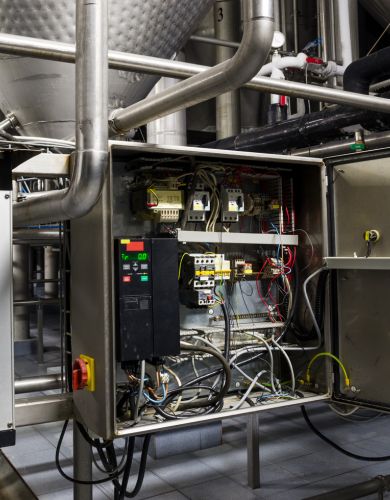What Is VSD Cooling?
Post By: Ryan King On: 14-12-2023 Read Time: 4 minutes - Guides
Post By: Ryan King On: 14-12-2023 Read Time: 4 minutes - Guides
Automation and construction sectors use air compressors to power pneumatic tools, painting machines and other industrial systems. Pressurised air compressor tanks generate heat in operation. When this warm air exits the systems, it cools and the moisture it carries forms condensation. For an air compressor to operate efficiently, corrosion and contaminants must be kept at a minimum. This is where air chillers come in, cooling the air released from the compressor to reduce moisture.
Air chillers remove moisture through an air-to-air heat exchanger that pre-cools the incoming air. The compressed air is then cycled into an air-to-refrigerant heat exchanger to bring down the compressed air dew point. By running the air through these processes, the water vapour condenses and becomes liquid. This is collected and removed. At the end of the process, within the air-to-air heat exchanger, moisture-free air is warmed to reduce the relative humidity level. This prevents condensation from forming in piping downstream.
In manufacturing plants, the need for compressed air fluctuates with the factory’s processes, but traditional air compressors usually run at full capacity. When less air is required for certain processes, more energy is consumed than necessary, causing waste. Air compressors fitted with a variable speed drive (VSD) achieve considerable energy savings by automatically adjusting motor speed to air demand. Similarly, chillers equipped with a VSD can save on energy costs, while drying air until the dew point is stable.
Conventional air chillers typically operate a reciprocating (piston) compressor at one fixed speed. This means that the chiller operates in an “on or off” capacity – the same limitation that fixed-speed air compressors have. For this reason, conventional chillers are less energy-efficient. VSD chillers on the other hand function with a scroll compressor using one spiral element orbiting around a second. VSD technology is more compact, quiet and efficient. The inverter that drives the scroll component can vary the speed to match demand, for improved energy efficiency.
The main benefit of using a VSD chiller is that it doesn’t load and unload the compressor, which creates a fluctuating sawtooth pressure profile. Instead, a VSD chiller adjusts the compression element to speed up or slow down the output capacity according to the compressed air demand. By syncing the output to demand, the VSD maintains the system’s pressure at a consistent level, saving on energy.
Another advantage of VSD chillers is that they provide a reliable supply of quality dry air at a stable, low dew point, irrespective of ambient air temperature.

When used with pumps, a VSD adjusts the pump’s flow or pressure to demand. Traditionally, VSDs have been used in irrigation for operational purposes such as providing soft starts, constant pressure outputs, and reducing wear.
As energy costs have increased over the years, energy conservation has become an important issue for businesses. In horticulture, for example, irrigation costs are typically higher because is more water being pumped than required for the crop. Another significant reason for water and energy waste is the installation of low-quality pumps with low operating efficiency. Also, higher than necessary pumping pressure or operating head results in waste.How VSDs Function With Pumps
When speed pumps are installed to cover a range of tasks, they are usually sized to meet the highest level of output demand. For this reason, some pumps are oversized and are ineffective for lower-demand outputs. The result is wasted energy during periods of low demand. By fitting a variable-speed drive to pumps, output will adjust according to demand, saving on energy.
With VSDs, pumps can still be fitted to meet maximum requirements without energy waste during low demand. VSDs also provide convenience and flexibility, as pumps can be adjusted according to output demands.
Energy saving is the primary benefit of a VSD pump, especially with more manufacturing plants seeking to reduce life cycle costs and adhere to sustainability plans. VSD pumps also have the benefit of accurate control of the pump system. With the VSDs operating the pump system, linking to other automation systems is simplified with fieldbus gateways.
VSDs allow for regular small variations in pump speed, making them a good option for pumps that require high variable demands. Other significant advantages of VSD pumps include reducing waste, pressure on electrical supply and redundancy. Redundancy with VSD pumps allows parallel pumps to function simultaneously, so one pump can pick up if the other fails. All these advantages minimise maintenance and repair costs in the long run.
Energy saving and limiting waste are the distinct advantages of installing VSD chillers and pumps, but energy savings have other benefits for manufacturers. Reducing emissions, preserving natural resources and complying with international standards are more reasons why manufacturers are seeking to reduce energy costs.
Some countries and companies have strict guidelines for the permissible harmonic content of current and voltage. These guidelines are designed to prevent damage to equipment in the manufacturing environment. VSDs minimise offending harmonics while maintaining maximum uptime for the pumping unit. By minimising the risk of harmonics damage with VSDs, plant operators can avoid penalties related to harmonics and operate more safely.
Despite the costs associated with some VSDs, they provide a high return on investment value by saving energy. Better still, their prices have reduced over the years, making them more accessible.